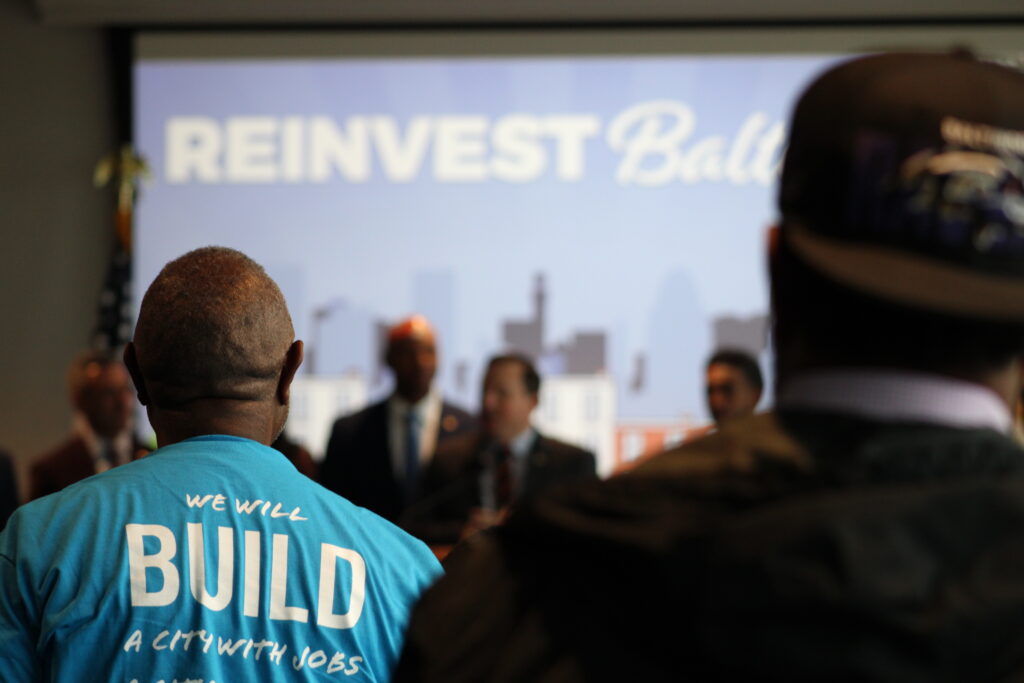Advocates listen Tuesday as Gov. Wes Moore and Senate President Bill Ferguson announce the launch of “Reinvest Baltimore” to help reduce the number of vacant lots and houses in the city. Photo by Danielle J. Brown
Gov. Wes Moore (D) traveled to “the most vacant and abandoned” part of Baltimore Tuesday to unveil a revamped program aimed at reducing the number of vacant houses and lots in the city.
The executive order signed at the Bon Secours Community Resource Center in West Baltimore launched the Reinvest Baltimore initiative, which renames a previous program aimed at blighted properties and calls on state, city and private organizations to cooperate on solving the problem.
“Right now, Baltimore has roughly 13,000 vacant and abandoned homes or structures and has more than 20,000 vacant lots,” Moore said Tuesday. “If we want to drive investment and we want to drive growth, we need to address the vacancy problem in Baltimore.”
Blighted properties have long been an issue in Baltimore, according to Housing and Community Development Secretary Jake Day. He said that concentrated vacant housing is a result of the “strangulation of life in our cities through racist housing policies like redlining.”
“Across the city, people deserve to live in safe, healthy neighborhoods – lovable, thriving places,” Day said. He said that the problem will not improve “without the community at the table, without philanthropy at the table, without businesses at the table, and without the state.”
Gov. Wes Moore launches “Reinvest Baltimore” to help reduce the number of vacant lots and houses in the city on Oct. 1, 2024. Photo by Danielle J. Brown
The order signed Tuesday renames a current DHCD anti-blight program known as Project C.O.R.E. (Creating Opportunities for Revitalization and Equity) as the Baltimore Vacants Reinvestment Initiative. The newly renamed initiative will focus on creating more greenspace, housing options and job opportunities in the city. The Baltimore Vacants Reinvestment Initiative will also have access to $50 million in state funds that are already set aside in the current budget for revitalization efforts.
The order also creates a Baltimore Vacants Reinvestment Council to help local and state agencies coordinate efforts and “address at least 5,000 vacant properties over next five years,” Moore said.
Moore said that the futures of vacant homes and lots will depend on each property – some may be repurposed and some may be demolished in favor of other developments – but the decisions will be made “in coordination with local leaders.”
The council will be chaired by the secretary of Housing and will include various state and local agency heads or their designees as well as people with backgrounds in real estate or planning.
The council is charged with obtaining “private, philanthropic and federal funding” to support the new program and recommending strategies to reduce the number of vacant lots throughout the city. It will also be called on to develop VacantStat, a public data dashboard to measure and monitor the progress of Reinvest Baltimore.
The executive order will stay in effect until Jan. 15, 2027, unless modified or rescinded.
“The goal is to end vacancy in Baltimore,” Baltimore Mayor Brandon Scott (D) said after the signing. “The key has been not having the funding and collaboration … Making sure we’re investing in the communities for affordable housing, working with developers, big and small.”

